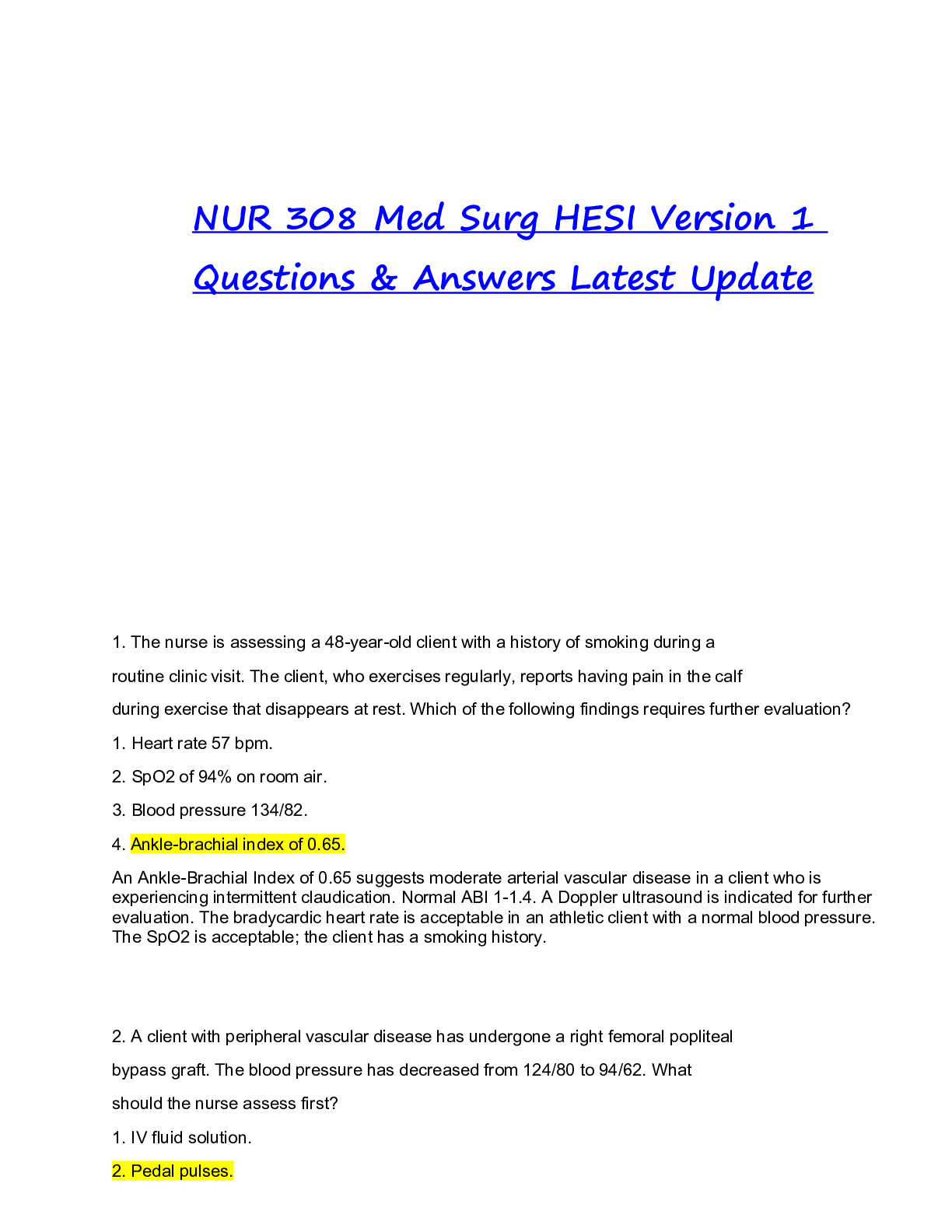Financial Accounting > QUESTIONS & ANSWERS > BACC 3119: Chapter 11. Most tested questions and quick read questions and answers for exam review. (All)
BACC 3119: Chapter 11. Most tested questions and quick read questions and answers for exam review.
Document Content and Description Below
Chapter 11 Distinguish between a contingent liability and an actual liability and give three examples of each. Contingent liabilities Actual liabilities Income tax disputes Accounts payable Gu... arantees of obligations of others Accrued salaries and wages Unused balances of outstanding letters of credit Income tax payable Explain why an auditor is interested in a client's future commitments to purchase raw materials at a fixed price. Explain why the analysis of legal expense is an essential part of every audit. Distinguish between an asserted and an unasserted claim. Explain why a client's attorney may not reveal an unasserted claim. Describe the action that an auditor should take if an attorney refuses to provide information that is within the attorney's jurisdiction and may directly affect the fair presentation of the financial statements. Distinguish between contingent liabilities and commitments and explain why both are important in an audit. Next, define commitment. Now, explain why contingent liabilities and commitments are important in an audit. Identify three useful audit procedures for uncovering contingent liabilities that Johnson will likely perform in the normal conduct of the audit, even if she had no responsibility for uncovering contingencies. Identify three other procedures Johnson is likely to perform specifically for the purpose of identifying undisclosed contingencies to help her obtain evidence about the presentation audit objective. Identify three useful audit procedures for uncovering commitments that Johnson will likely perform as part of the audit in other accounts. A contingency is a potential future obligation to an outside party for an unknown amount resulting from activities that have already taken place. Material contingent liabilities must be disclosed in the footnotes. Define contingent liability. Describe the audit procedures you would use to learn about each of the situations listed. Discuss the existence and nature of possible contingent liabilities with management and obtain appropriate written representations. Identify all of the audit procedures you would use to learn about situation 2. Identify all of the audit procedures you would use to learn about situation 3. The lawsuit should be described in a footnote to the balance sheet. A journal entry should be made as of December 31, 20192019, to reflect the contingent liability. The balance sheet should also be footnoted to the effect that the MillerMiller Corporation is contingently liable for future interest payments on NanaNana Company bonds. Identify five audit procedures normally done as a part of the review for subsequent events. Obtain a letter of representation. Which of the following would be least likely to be included in a standard inquiry to the client's attorney? This is a subsequent discovery of facts The auditor's responsibilities related to the audit opinion are: The auditor has an obligation to ensure that users of the financial statements are informed about the misstatement and that the audit opinion should no longer be relied upon. If the client refuses to disclose the misstatement, the auditor should inform the board of directors. Ensure the client informs the SEC and other regulatory agencies of the misstatement, and issues revised financial statements with an explanation of the reason for the revision. If the auditor's original opinion on internal controls concluded that controls were effective, then they would evaluate the new information related to the material weakness to determine whether the material weakness existed as of the balance sheet date aware of the revised information and reissue a report on the effectiveness of internal controls to disclose the material weakness. a. On December 14, 20192019, the auditor discovered that a debtor of Tracy Brewing went bankrupt on July 15, 20192019, due to declining financial health. The sale generating the receivable had taken place January 15, 20192019. (Select two justifications for this event). b. On December 14, 20192019, the auditor discovered that a debtor of Tracy Brewing went bankrupt on October 2, 20192019. The sale had taken place April 15, 20192019, but the amount appeared collectible at June 30, 20192019, and August 19, 20192019. c. On August 15, 20192019, the auditor discovered that a debtor of Tracy Brewing went bankrupt on August 1, 20192019. The most recent sale had taken place April 2, 20182018, and no cash receipts had been received since that date. d. On July 20, 20192019, Tracy Brewing settled a lawsuit out of court that had originated in 20162016 and is currently listed as a contingent liability. e. On September 14, 20192019, Tracy Brewing lost a court case that had originated in 20182018 for an amount equal to the lawsuit. The June 30, 20192019, footnotes state that in the opinion of legal counsel there will be a favorable settlement. f. On July 20, 20192019, a lawsuit was filed against Tracy Brewing for a patent infringement action that allegedly took place in early 20192019. In the opinion of legal counsel, there is a danger of a significant loss to the client. (The loss cannot be reasonably estimated.) g. On May 31, 20192019, the auditor discovered an uninsured lawsuit against Tracy Brewing that had originated on February 28, 20192019. h. On August 6, 20192019, the auditor discovered that a debtor of Tracy Brewing went bankrupt on July 30, 20192019. The cause of the bankruptcy was an unexpected loss of a major lawsuit on July 15, 20192019, resulting from a product deficiency suit by a different customer. (Select two justifications for this event). A client acquired 25 percent of its outstanding capital stock after year end but prior to the date of theauditor's report. The auditor should advise management to disclose the acquisition in the notes to the financial statements. Which of the following statements is correct about an auditor's required communication with those charged with governance? Distinguish between a management letter and a letter about significant deficiencies in internal control. Give examples of items that might be included in a management letter. to segregate duties Describe matters that the auditor must communicate to audit committees of public companies. Which of the following is not a required item to be communicated by the auditor to the audit committee or others charged with governance? Recommendations for improving the client's business. Written management representations obtained by the auditor in connection with a financial statement audit should include a statement of management's belief that the effects of uncorrected misstatements are not material. A management letter contains recommendations from the auditor designed to help the client improve the efficiency and effectiveness of its business. According to auditing standards, what is the auditor's obligation to consider whether the client can continue as a going concern? Auditing standards require the auditor to evaluate whether there is substantial doubt about a client's ability to continue as a going concern for a reasonable period of time based on the accounting standards framework that management has used to prepare the financial statements. Auditors make this evaluation during the planning phase, but also update their assessment throughout the audit using information obtained from analytical procedures, discussions with management, their knowledge of the client's business and other information that comes to light during the audit. Assuming management is using U.S. GAAP to prepare the financial statements, the auditor is required to consider whether the client is able to continue as a going concern for at least one year after the date the financial statements are issued. Begin by selecting the factors discussed in the problem statement that are relevant for a going-concern assessment for MakingNewFriends.com. MakingNewFriends.com has had difficulty establishing a loyal client base and generating advertising revenues. Management's plan to increase advertising revenues by 20%. The recurring operating losses and decline in working capital. Management's plan to obtain debt financing as a means to fund operations for the next year, although they have not yet secured such financing. Next, select the additional information the auditor might consider in their going-concern assessment. Other plans by management to generate revenue or other financing for the coming year. Knowledge of industry trends and possibly analyst forecasts related to this market segment, and performance of competitors. The auditor is required to evaluate the feasibility of management achieving their plans. For example, the auditor may discuss with the bank the likelihood of the company obtaining financing. How does an auditor evaluate the unadjusted misstatement schedule (also called summary of possiblemisstatements) at the end of the audit engagement to assess whether the financial statements are fairlypresented? A summary of unadjusted misstatement schedule is used by the auditor to accumulate any misstatements identified during the audit that may not be individually material, but may be material when aggregated. At the end of the audit, the auditor will evaluate all misstatements collectively to assess whether individual accounts or financial statement categories such as total assets, liabilities, equity, revenues, expenses, or net income, are materially misstated. If the auditor concludes that an account or financial statement category is materially misstated after aggregating individually immaterial misstatements, the auditor will request that the client correct at least some of the misstatements or issue a qualified or adverse opinion. The auditor considers the impact on the current year financial statements of any misstatements that were identified in the prior year but not corrected. Information accompanying basic financial statements is any and all information prepared by management for outside users included with the basic financial statements. Examples of information accompanying basic financial statements include: statistical data such as ratios and trends detailed comparative statements supporting control totals in the basic statements The auditor can provide one of two levels of assurance for information accompanying basic financial statements. The auditor may issue a positive opinion indicating a high level of assurance or a disclaimer indicating no assurance. What is the difference between basic financial statements and additional information? A typical additional information report includes the financial statements associated with a standard report on the basic financial statements plus additional information likely to be useful to management and other statement users. The statements included with standard audit reports are defined by the profession, but the additional information included in additional information reports varies considerably. What are the purposes of additional information accompanying basic financial statements? The purpose of additional information reports is to provide management and other users Items Included/Excluded as Additional Information Reasons to Exclude the Item as Additional Information 1. A schedule of insurance in force. 2. The auditor's feelings about the adequacy of the insurance coverage. 3. An aged trial balance of accounts receivable and evaluation of the adequacy of the allowance for uncollectible accounts. 4. A summary of fixed asset additions. 5. Material weaknesses in internal control and recommendations to improve internal control. 6. A 5-year summary of the most important company ratios, with the appropriate ratios to be determined at the auditor's discretion. 7. A schedule of notes payable accompanied by interest rates, collateral, and a payment schedule. Assume that an unmodified opinion is appropriate for the basic financial statements report, that no testing was done beyond that required for the basic financial statements report, and that only appropriate information is included in the additional information. Write the proper auditor's report. The following would be added to the standard audit report as an explanatory paragraph: Our audit was conducted for the purpose of forming an opinion on the basic financial statements taken as a whole. The accompanying supplementary information on pages x through y is presented for purposes of additional analysis and is not a required part of the basic financial statements. Such information has not been subjected to the auditing procedures applied in the audit of the basic financial statements, and,accordingly, we express no opinion on it. Describe a client letter of representation. The purposes of the letter of representation are to: What types of information are normally included in the letter? ALL APPLY EXCEPT . [Show More]
Last updated: 1 year ago
Preview 1 out of 15 pages
Instant download

Buy this document to get the full access instantly
Instant Download Access after purchase
Add to cartInstant download
Reviews( 0 )
Document information
Connected school, study & course
About the document
Uploaded On
Dec 10, 2020
Number of pages
15
Written in
Additional information
This document has been written for:
Uploaded
Dec 10, 2020
Downloads
0
Views
33













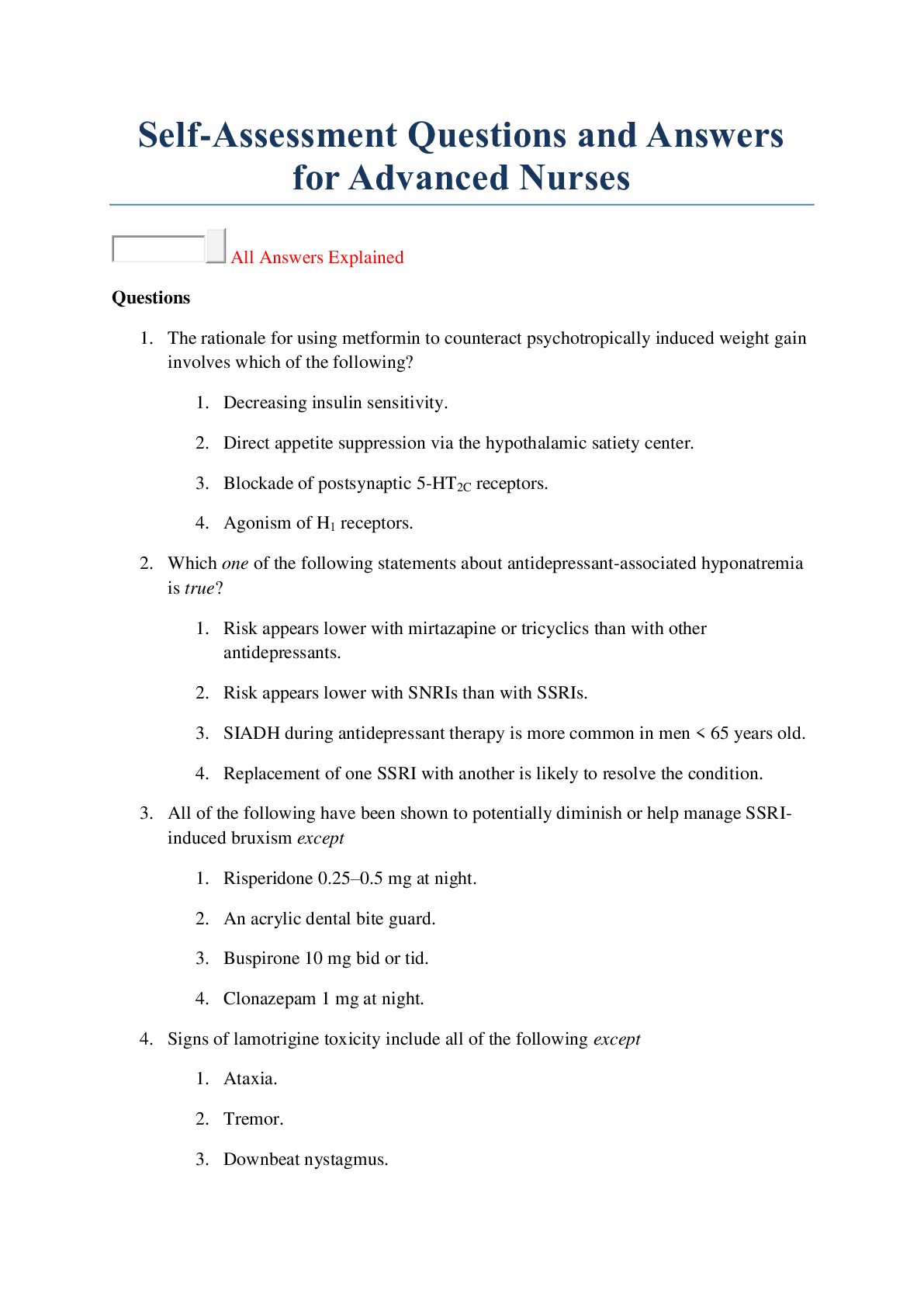
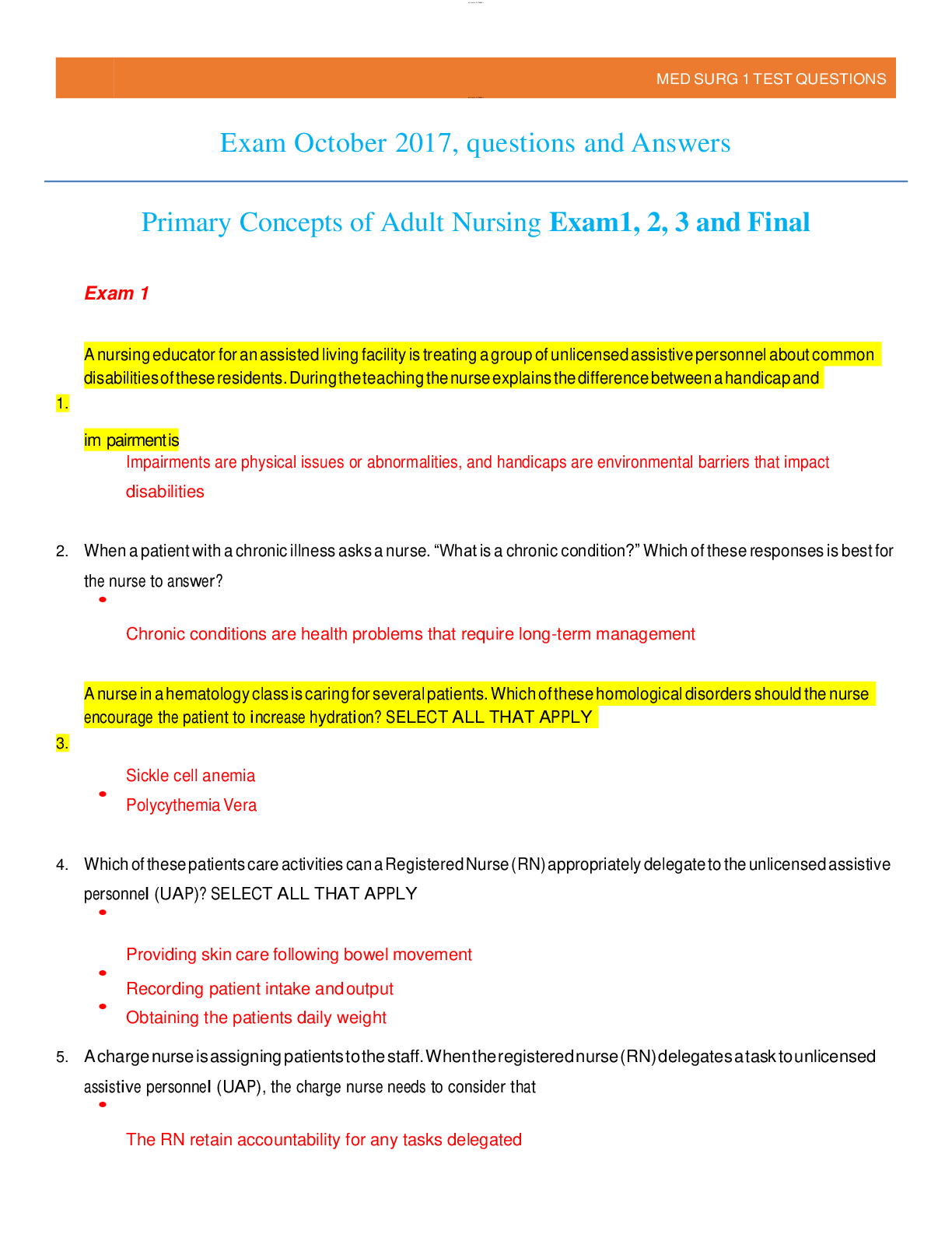


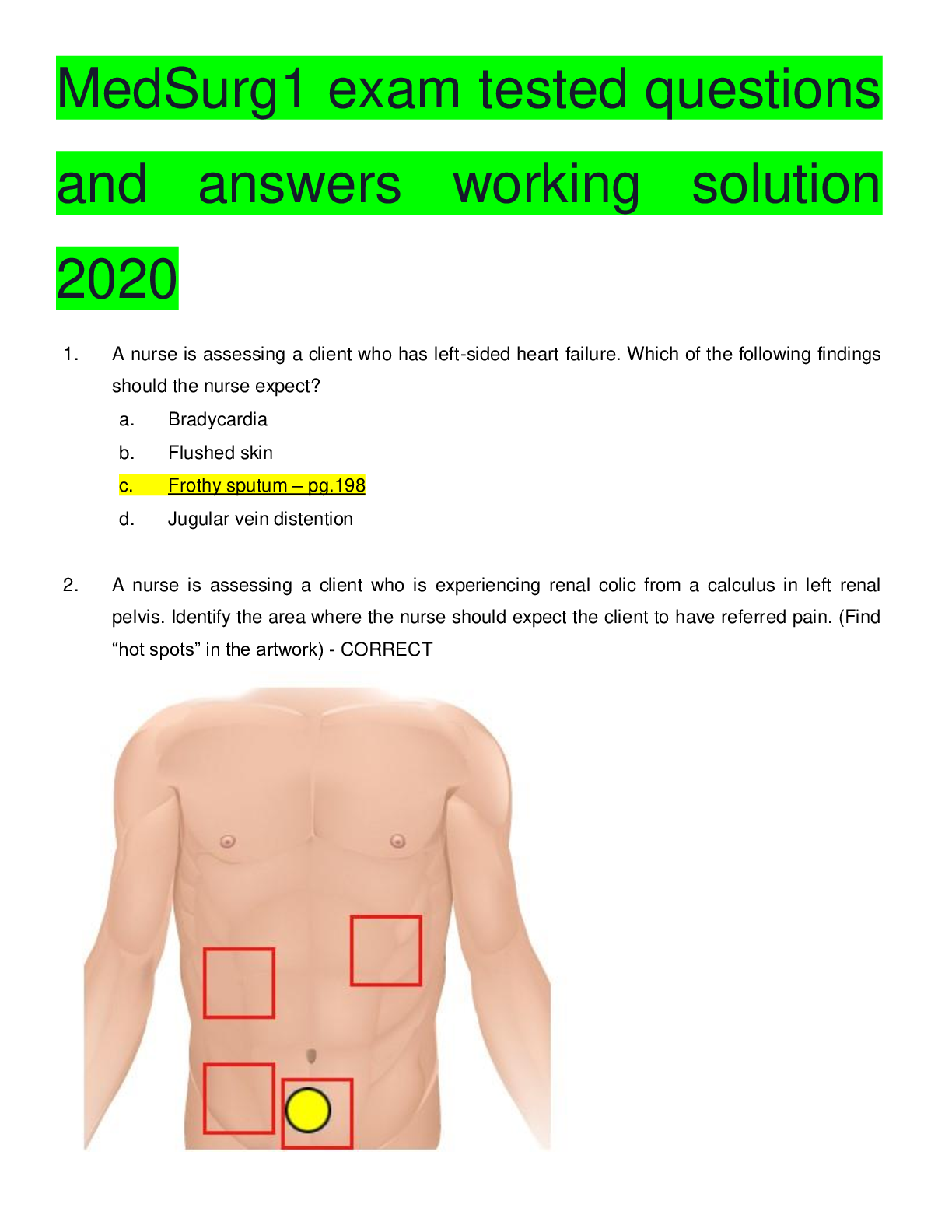
 answers.png)
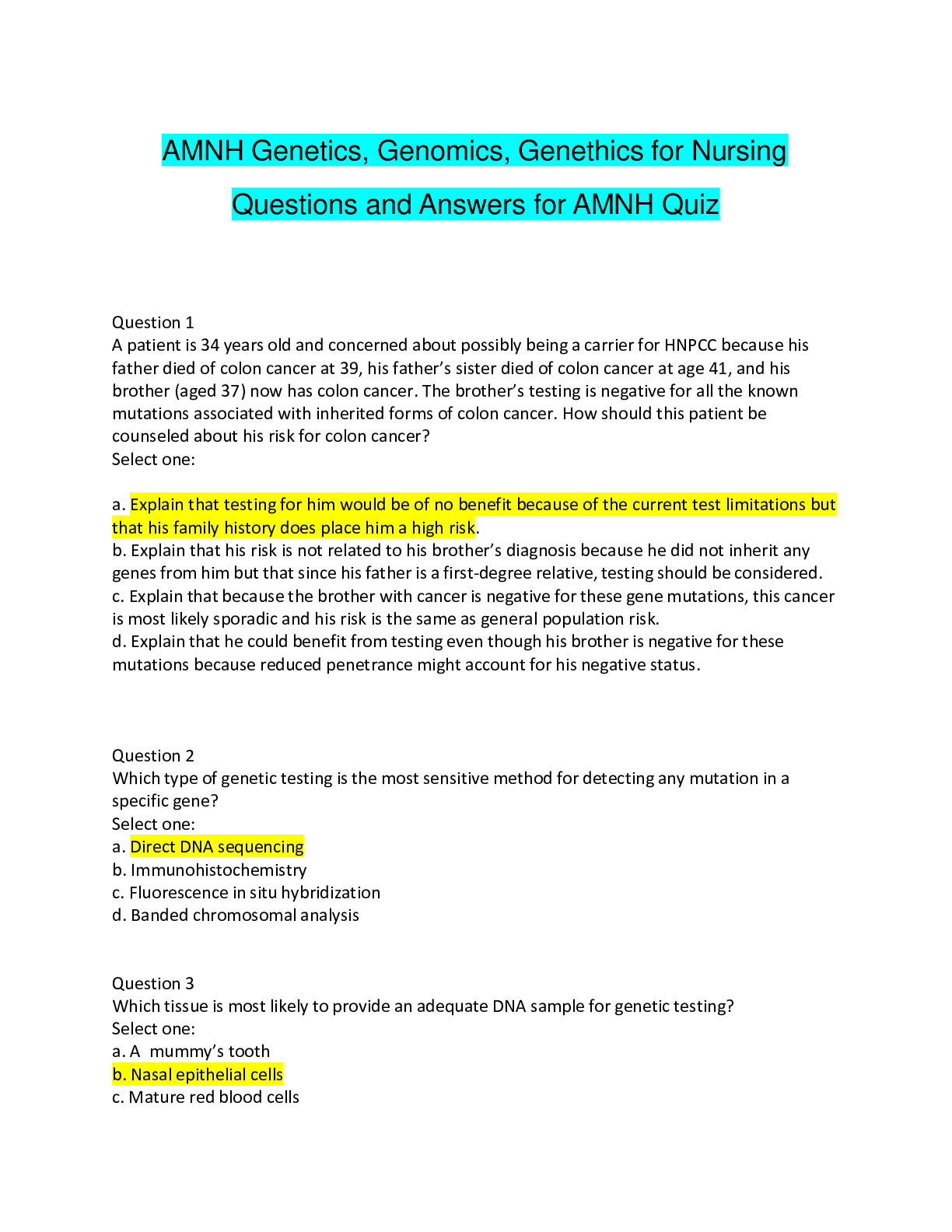

.png)
